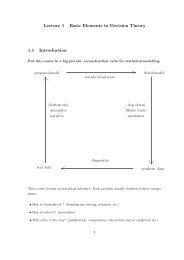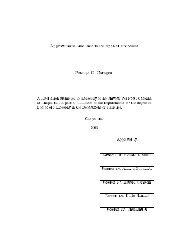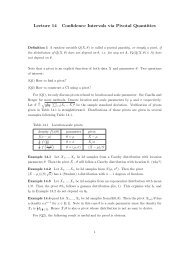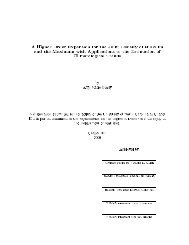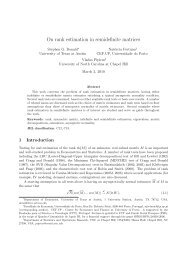Monte Carlo Methods in Statistical Mechanics: Foundations and ...
Monte Carlo Methods in Statistical Mechanics: Foundations and ...
Monte Carlo Methods in Statistical Mechanics: Foundations and ...
You also want an ePaper? Increase the reach of your titles
YUMPU automatically turns print PDFs into web optimized ePapers that Google loves.
F<strong>in</strong>ally, let us see what happens if we sumover the f g at xed fng. Each occupied<br />
bond hiji imposes a constra<strong>in</strong>t that the sp<strong>in</strong>s i <strong>and</strong> j mustbe<strong>in</strong>the same state,<br />
but otherwise the sp<strong>in</strong>s are unconstra<strong>in</strong>ed. We therefore group the sites <strong>in</strong>to connected<br />
clusters (two sites are <strong>in</strong> the same cluster if they can be jo<strong>in</strong>ed by apath of occupied<br />
bonds) then all the sp<strong>in</strong>s with<strong>in</strong> a cluster mustbe<strong>in</strong>the samestate (all q values are<br />
equally probable), <strong>and</strong> dist<strong>in</strong>ct clusters are <strong>in</strong>dependent. It follows that<br />
Z = X<br />
fng<br />
0<br />
@ Y<br />
hiji: nij=1<br />
pij<br />
1 0<br />
A @ Y<br />
hiji: nij=0<br />
1<br />
(1 ; pij) A q C(n) (6.7)<br />
where C(n) isthe number of connected clusters (<strong>in</strong>clud<strong>in</strong>g one-siteclusters) <strong>in</strong> the graph<br />
whose edges are the bonds hav<strong>in</strong>g nij =1. The correspond<strong>in</strong>g probability distribution,<br />
RC(n) = Z ;1<br />
0<br />
@ Y<br />
hiji: nij=1<br />
pij<br />
1 0<br />
A @ Y<br />
hiji: nij=0<br />
1<br />
(1 ; pij) A q C(n) (6.8)<br />
is called the r<strong>and</strong>om-cluster model with parameter q. This is a generalized bondpercolation<br />
model, with non-local correlations com<strong>in</strong>g fromthe factor q C(n) forq =1<br />
it reduces to ord<strong>in</strong>ary bond percolation. Note, by the way, that <strong>in</strong>the r<strong>and</strong>om-cluster<br />
model (unlike the Potts <strong>and</strong>FKSWmodels), q is merely a parameter it can take any<br />
positiverealvalue, not just 2 3:::.Sother<strong>and</strong>om-cluster model de nes, <strong>in</strong> some sense,<br />
an analytic cont<strong>in</strong>uation of the Potts model to non-<strong>in</strong>teger q ord<strong>in</strong>ary bond percolation<br />
corresponds to the \one-state Potts model".<br />
We have already veri ed the follow<strong>in</strong>g factsabout the FKSWmodel:<br />
a) ZP otts = ZFKSW = ZRC.<br />
b) The marg<strong>in</strong>al distribution of FKSW on the Potts variables f g (<strong>in</strong>tegrat<strong>in</strong>g out<br />
the fng) is precisely the Potts model Potts( ).<br />
c) The marg<strong>in</strong>al distribution of FKSW on the bondoccupation variables fng (<strong>in</strong>tegrat<strong>in</strong>g<br />
outthe f g) is precisely the r<strong>and</strong>om-cluster model RC(n).<br />
The conditional distributions of FKSW are also simple:<br />
d) The conditional distribution of the fng given the f g is as follows: <strong>in</strong>dependently<br />
for each bond hiji, onesets nij = 0 <strong>in</strong> case i 6= j, <strong>and</strong>sets nij =0 1with<br />
probability 1; pijpij, respectively,<strong>in</strong>case i = j.<br />
e) The conditional distribution of the f g given the fng is as follows: <strong>in</strong>dependently<br />
for each connected cluster, one sets all the sp<strong>in</strong>s i <strong>in</strong> the cluster to thesamevalue,<br />
chosen equiprobably from f1 2:::qg.<br />
47



